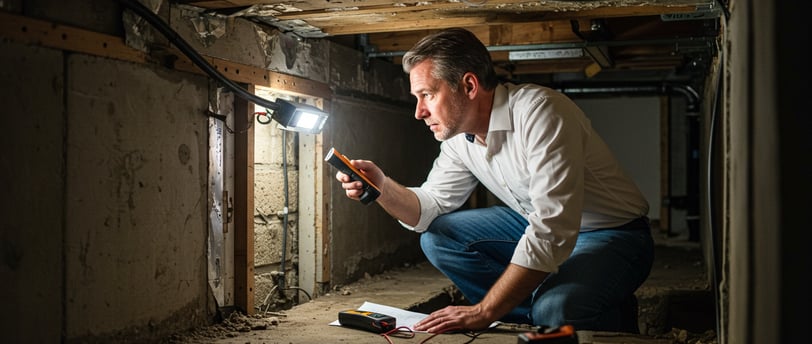Property Inspection Checklist for Buyers
Don't miss a thing when buying a home! This property inspection checklist covers everything you need to check, from structural issues to hidden repairs, ensuring a smart and confident purchase.
DIYHOME INSPECTIONTIPS FOR SUCCESS
3/6/20253 min leer


Buying a home is one of the most exciting yet nerve-wracking experiences in life. Whether you’re a first-time homebuyer or a seasoned investor, ensuring the property is in good condition is crucial. A property inspection allows you to identify potential issues before committing to a purchase. This guide will walk you through a comprehensive property inspection checklist, covering essential areas you should examine before making a final decision.
Why Property Inspections Matter
A home may look perfect on the outside, but hidden issues can lead to costly repairs down the line. A thorough inspection helps you:
Identify safety hazards
Determine necessary repairs or upgrades
Evaluate structural integrity
Negotiate a better deal with the seller
Avoid unexpected expenses after purchase
By using this property inspection checklist, you’ll gain peace of mind and make an informed decision when buying a home.
Exterior Inspection
The exterior of a home is your first line of defense against the elements. Issues with roofing, siding, or drainage can lead to serious damage if not addressed.
1. Roof
Are there missing, curled, or damaged shingles?
Is there any visible sagging or structural weakness?
Check for signs of leaks, water damage, or mold in the attic.
Are gutters and downspouts properly attached and draining away from the house?
2. Foundation and Structure
Look for cracks in the foundation walls, especially near doors and windows.
Check for sloping floors, which may indicate structural issues.
Ensure there is no water pooling around the foundation, which could lead to basement leaks.
3. Siding, Paint, and Exterior Walls
Is there peeling paint, cracks, or signs of rot?
Are there gaps or holes that could allow pests to enter?
Check brickwork or stucco for cracks and deterioration.
4. Windows and Doors
Are the frames in good condition without warping or gaps?
Do all windows open and close properly?
Check for broken glass or signs of condensation between double panes.
5. Driveway, Walkways, and Landscaping
Look for cracks, uneven surfaces, or tripping hazards.
Ensure trees and bushes are not too close to the house, which can cause foundation or roof issues.
Check for proper grading to prevent water from pooling near the foundation.
Interior Inspection
Inside the home, you want to ensure all systems are functioning correctly and that no major repairs are needed.
6. Walls, Ceilings, and Floors
Look for cracks, water stains, or signs of mold.
Are there any uneven surfaces or sagging areas?
Check for squeaky or loose floorboards.
7. Plumbing System
Test water pressure in sinks, showers, and tubs.
Look for leaks under sinks and around toilets.
Ensure hot water is available and the water heater is in good condition.
8. Electrical System
Test light switches and outlets to ensure they work.
Look for exposed wiring or outdated electrical panels.
Check for signs of electrical burning or flickering lights.
9. Heating, Ventilation, and Air Conditioning (HVAC)
Turn on the heating and cooling systems to ensure they function properly.
Inspect air filters and vents for dust buildup.
Listen for unusual noises from the HVAC system.
10. Kitchen and Appliances
Test the stove, oven, and microwave.
Check that the refrigerator, dishwasher, and garbage disposal work.
Inspect countertops, cabinets, and drawers for damage.
11. Bathrooms
Flush all toilets to ensure they work properly.
Check for leaks around sinks, tubs, and showers.
Look for signs of mold or mildew.
Attic and Basement Inspection
The attic and basement often reveal underlying issues that may not be visible elsewhere.
12. Attic
Check for proper insulation and ventilation.
Look for signs of leaks or moisture damage.
Inspect for pests such as rodents or insects.
13. Basement and Crawl Space
Look for dampness, mold, or mildew.
Check for cracks in the walls or floor.
Ensure sump pumps and drainage systems are functional.
Safety and Security Features
Ensuring the home meets safety standards can protect you and your family from potential hazards.
14. Smoke and Carbon Monoxide Detectors
Make sure they are installed in key locations and functioning properly.
Locate the date of installation, which should be written on the device.
15. Fireplace and Chimney
Check for soot buildup or cracks in the chimney.
Ensure the flue opens and closes properly.
16. Stairs, Railings, and Balconies
Test railings for stability and ensure stairs are secure.
Look for loose boards or signs of wear on balconies.
Final Walkthrough Before Purchase
Once you’ve completed your inspection, take a final walkthrough before closing the deal.
Double-check that agreed-upon repairs have been completed.
Verify that all appliances and systems are still functioning.
Ensure no new damage has occurred since the initial inspection.
Conclusion
A thorough property inspection can save you from costly surprises and help you negotiate a better deal. By carefully reviewing each part of the home, from the roof to the basement, you can make a confident and informed purchase. Whether you conduct the inspection yourself or hire a professional, this checklist ensures you cover all critical areas before signing on the dotted line.
Quantum Scope Inspections
La Salud de Su Hogar, Nuestra Prioridad
Consiga el Manual del Vendedor de Viviendas, Edición 2025
Maximice su inversión con reparaciones y mantenimiento en Amazon.
© QuantumScope Inspections 2025 | Todos los Derechos Reservados | Política de Privacidad
Diseño web por Creative Web Design Lab
